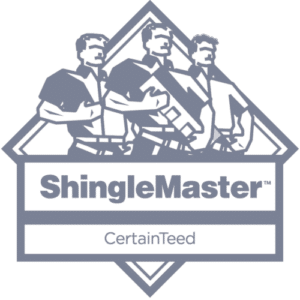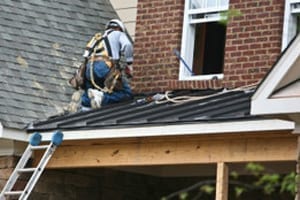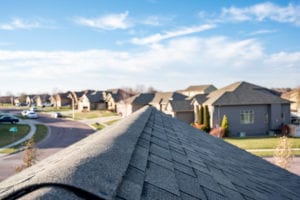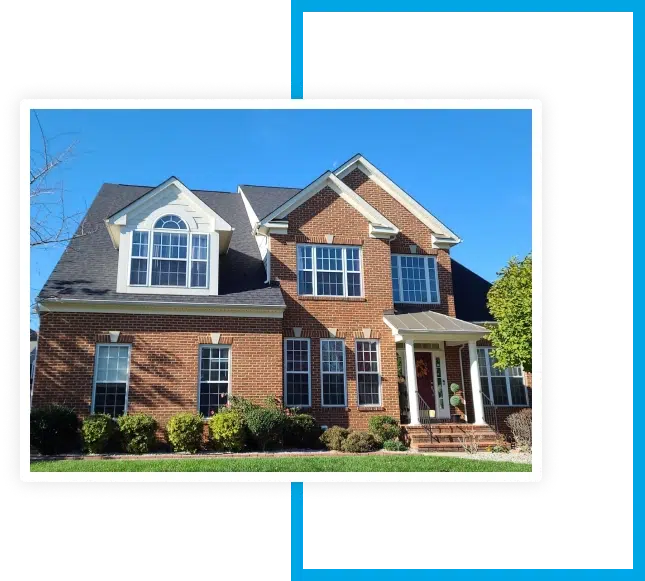If you’re in the market for a new commercial roof, you probably recognize it’s a big undertaking. Not only are there many different options on the market, but there are also many different contractors to choose from. Today we’re taking what you’d find in a complete guide and condensing it for your review. We’re walking through the most common types of commercial roofing choices and the pros and cons of each.
There are many commercial roofing systems available, but not all make the most sense for every building. A low slope roof will have different options than flat-type roofs. And a building focused on energy efficiency will have other choices than one that needs a fire-resistant roof system. From metal tile sheets and green roofs to EPDM roofing and a built-up roofing system, we’re covering it all: the good, the bad (and even some of the color choices).

Common Commercial Roofing Material Options
There are many roofing materials available for a commercial roof. We’re covering the most common available roofing systems and sharing some of the pros and cons. From modified bitumen to EPDM, we’re unpacking your roofing system options.
Metal Roofing
These roofing materials are often made of (you guessed it) metals. The most common metal roofing materials are copper, steel, tin, aluminum, and zinc. When you think of a metal roof, you may think of shiny silver panels, but today, these roofing systems can be made of long metal pieces or tiles and come in many colors.
Pros and Cons
A commercial roofing system like metal roofing has many pros, including:
- Durability. These roofing materials can last between 40 and 70 years. And they typically don’t face challenges common with other roofing systems, such as cracking, chipping, and warping.
- Resistant to many roof enemies. They’re highly resistant to wind, fire, and thanks to interlocking panels, keep out water well too. Metal is non-porous, so it also withstands problems like algae and moss growth.
- Easy to maintain. Thanks to the pros above, these roofs are relatively easy to maintain and come with low ongoing costs.
So, what’s the downside? Metal roofing is not inexpensive. At $150-$600 or more per 100 square feet, metal roofs require a more significant upfront investment than many alternative roofing systems. Some people also complain about the noise level in storms and hailstorms as the weather makes contact with the metal. And, in the case of hailstorms, metal roofing can show bumps and dents more easily.
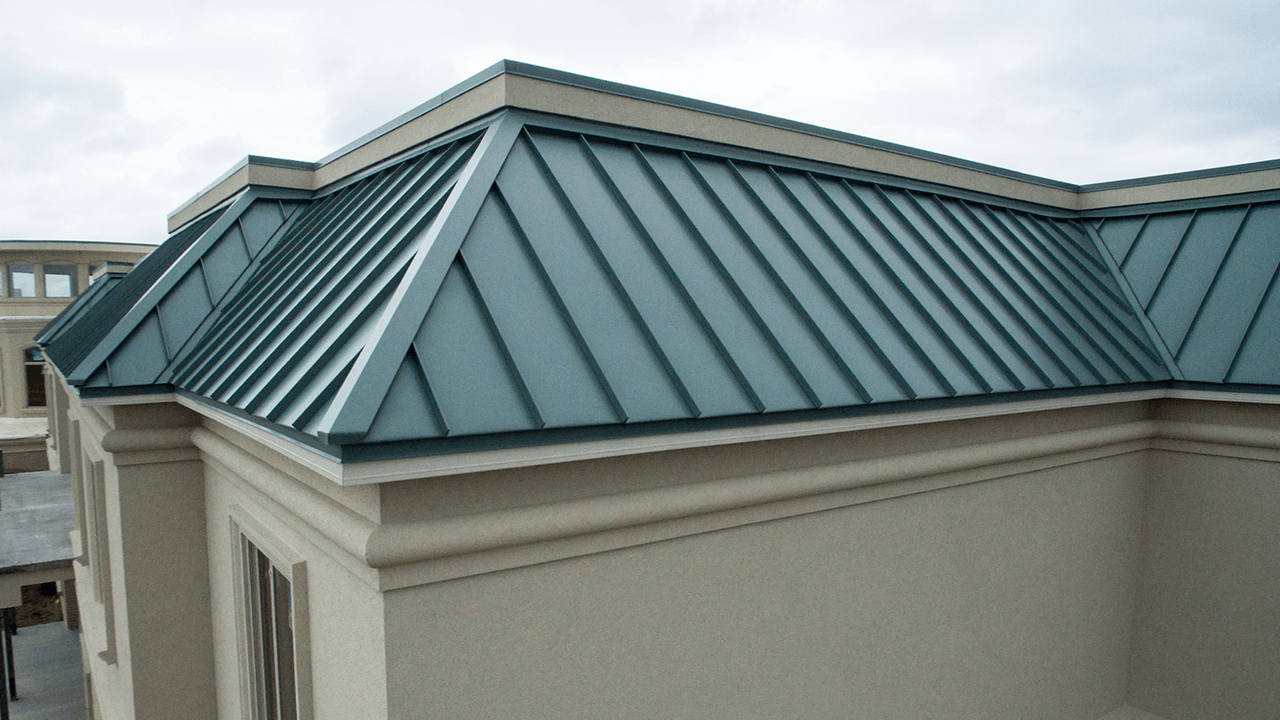
Built-Up Roofing (BUR) Membrane
Built-up roofing, often known as BUR, is a popular commercial roofing option for low-slow roofs and flat roofs. The BUR has roofing membranes that are created with layers of bitumen and other materials. Modified Bitumen is a similar roofing system that includes five layers. This extra protection makes it a favorite for commercial flat roofs and low slope projects.
Pros and Cons
- Fire-resistant. Built-up roofing membranes have several pros on their side, not least of which is fire resistance. They also create tight layers that make them waterproof and water-resistant, lowering the chance of leaks and water damage when installed correctly. This same sturdy material helps these roofing systems withstand all sorts of weather conditions.
- Limited Maintenance. Low maintenance is another pro in this roofing systems corner. While regular inspections are recommended for a bitumen roof and modified bitumen roofs, they typically require minimal upkeep.
- Energy Efficient. Energy efficiency is a bonus, thanks to the high reflectivity of this commercial roofing system.
So what’s the downside of bitumen and modified bitumen options? One of the primary challenges is open or split joints that happen over time as the seams dry and separate. If caught early, a patch may be an option rather than a total roof replacement. While a roofing membrane is water-resistant, over time, water pooling can cause problems. Inspect your roof membranes and roofing system after storms and make sure water can never pool for a period of time. This can lead to cracks in your bitumen roofing and eventually leaks. Blisters are one other problem to watch out for. Whether these form from water pooling or too much moisture that occurred during installation, they can cause bigger issues in the roofing membrane materials. Most of the cons we’ve covered can be managed if caught early. With proper installation and regular inspections, you can expect your bitumen and modified bitumen commercial roofing systems to last between 15 and 30 years.
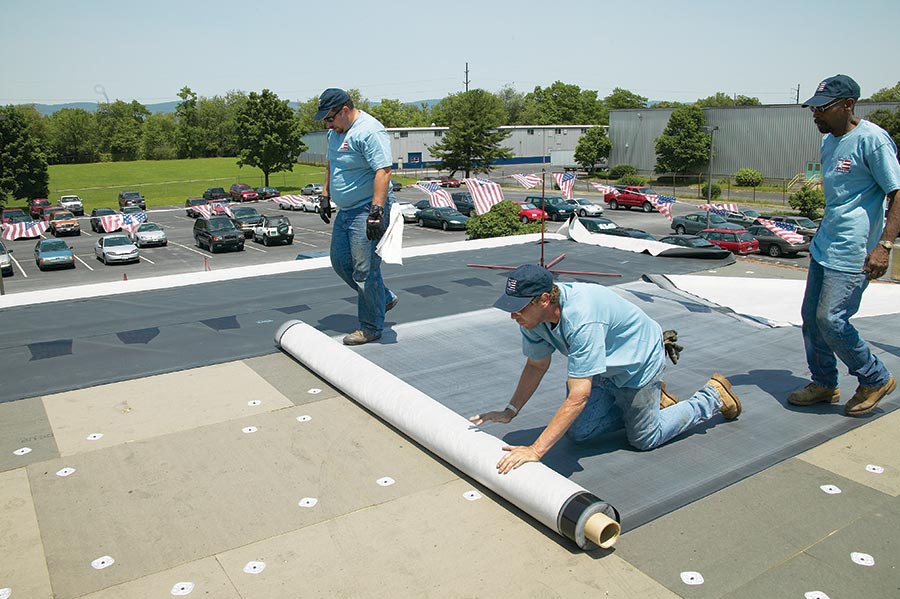
Green Roofing
A green commercial roof can also be known as a living roof. That’s because these roofs are partially or totally covered with live vegetation. These roof systems need a waterproofing membrane and layers that allow for drainage and irrigation systems. While they require a more significant initial investment than some alternative commercial roofing systems, these roofs are beautiful living structures that offer many benefits. With proper maintenance, the coverage provided by plants can extend your roof’s lifespan up to 50 years. They can also create beautiful additions to commercial buildings. Depending on the type of style you select, a green roof may be an option for flat-type roofs and low-sloped roofs.
Pros and Cons
- Positive Environmental Impact. Green roofing systems have several positives in their corner, not least of which is their incredible impact on the environment. These roofs improve the local air quality, thanks to the plant’s ability to produce oxygen. As well, green roofs create a unique curb appeal in comparison to traditional commercial roofs.
- Noise Reduction. Some customers are surprised to find that a green roof also offers noise reduction. But green roofs can better absorb and deflect sounds from the area more efficiently than other roof systems.
- Cost-Effective. A green roofing system is extremely energy-efficient. This is thanks to the plant’s ability to retain heat in the winter. In the summer, the plants ensure a cooling effect. Both of these functions help reduce the cost of electricity year-round.
The downside to these green roofs starts with their initial investment. Designing and installing a green roof is more expensive than other commercial roofing types. And anything completely custom will add to the initial cost of your commercial roofing project. These roofing systems also require more maintenance than alternatives like metal roofs or tar and gravel options. If plants are neglected and die, the benefit of the green roof is quickly lost. One other consideration is the possibility that your green roofing system could sustain damage and begin leaking. Leaks most frequently occur when the roots of the plants grow too deep and grow through the membrane. Once punctured, this waterproof base sheet can mean leaks are sure to follow – and more damage if not correctly repaired. Overall these green roofing options are a unique option to explore for your property. Not all building types are candidates, so talk to a professional roofing contractor before you go down this road. They’ll help you assess your existing structure, whether slope roofing or flat roofing, and make sure that it’s a good fit for your project, budget, and long-term goals.
Spray-On Silicone
A silicone roof coating is another roofing solution that some building owners consider for their commercial property. These materials can be rolled or sprayed on to restore and repair other roofing materials, such as tar and gravel roof types, single ply, EPDM roofing, and more. When appropriately used, silicone can create a solid, protective roofing surface for many years to come.
Pros and Cons
- Water Resistant. One of the best features of a silicone roof coating is its ability to survive ponding water that occurs on roofs without damage. This material works well on flat roofing and low slope roofing. Both can tend to pool water, so silicone offers an extra layer of protection for these low slope and flat commercial roofs.
- Energy Efficient. Silicone roof types are extremely energy efficient since it’s a roofing material that can reflect up to 90% of harmful UV rays. This is similar to an SPF roofing system that protects the building from heat transfer and provides building owners with decreased costs for electricity. The silicone material is also environmentally safe and contains very low VOCs (volatile organic compounds).
- Durability. Silicone materials can withstand extreme weather events well. The surface of these roof types can also handle the natural expansion and contraction that occurs in large buildings.
On the downside, coating a roofing membrane can be tricky and challenging to apply. This is why professional roofing contractors are a must for your project. Silicone can also easily attract dirt, so you may want to plan for regular upkeep if your roof is highly visible. Lastly, for flat roof types and low slope roofs, where traffic may occur regularly, keep in mind that silicone may be slippery. While flat roofs, in particular, may feel safe, extra care is necessary for anyone who walks on the roof.
Thermoset EPDM Roof Membrane
While thermoset EPDM (ethylene propylene diene methylene) roof membranes may sound overly technical, it’s actually just a synthetic rubber material that can be used to reinforce commercial roofing structures. This material is an excellent solution for flat roofs, sloped roofs, and more.
Pros and Cons
- Low Cost. EPDM is a low-cost type of material. It is the lowest for commercial flat roofs and low sloped roofs. And it’s a great value because it has a lifespan of more than 20 years when installed properly.
- Energy Efficient. EPDM roofing has options that make it extremely energy efficient.
- Durability. EPDM is flexible and can deal with structural fluctuations better than alternatives like TPO and PVC roofs. It also handles temperature fluctuations well and gets good fire resistance ratings in the industry. Thanks to its durability, repairs are often inexpensive for the owner and can be completed quickly by a professional.
On the cons list, EPDM is typically a roofing system that must be installed by a professional. When done improperly, it can begin leaking quickly. EPDM seams also need to be installed correctly as they tend to experience problems more rapidly than the comparable TPO and PVC alternatives. Some customers aren’t concerned with curb appeal for their commercial roofing system, but if you are, EPDM may not be the best material. It is fairly plain and doesn’t come with many color options like asphalt or metal roofing systems.
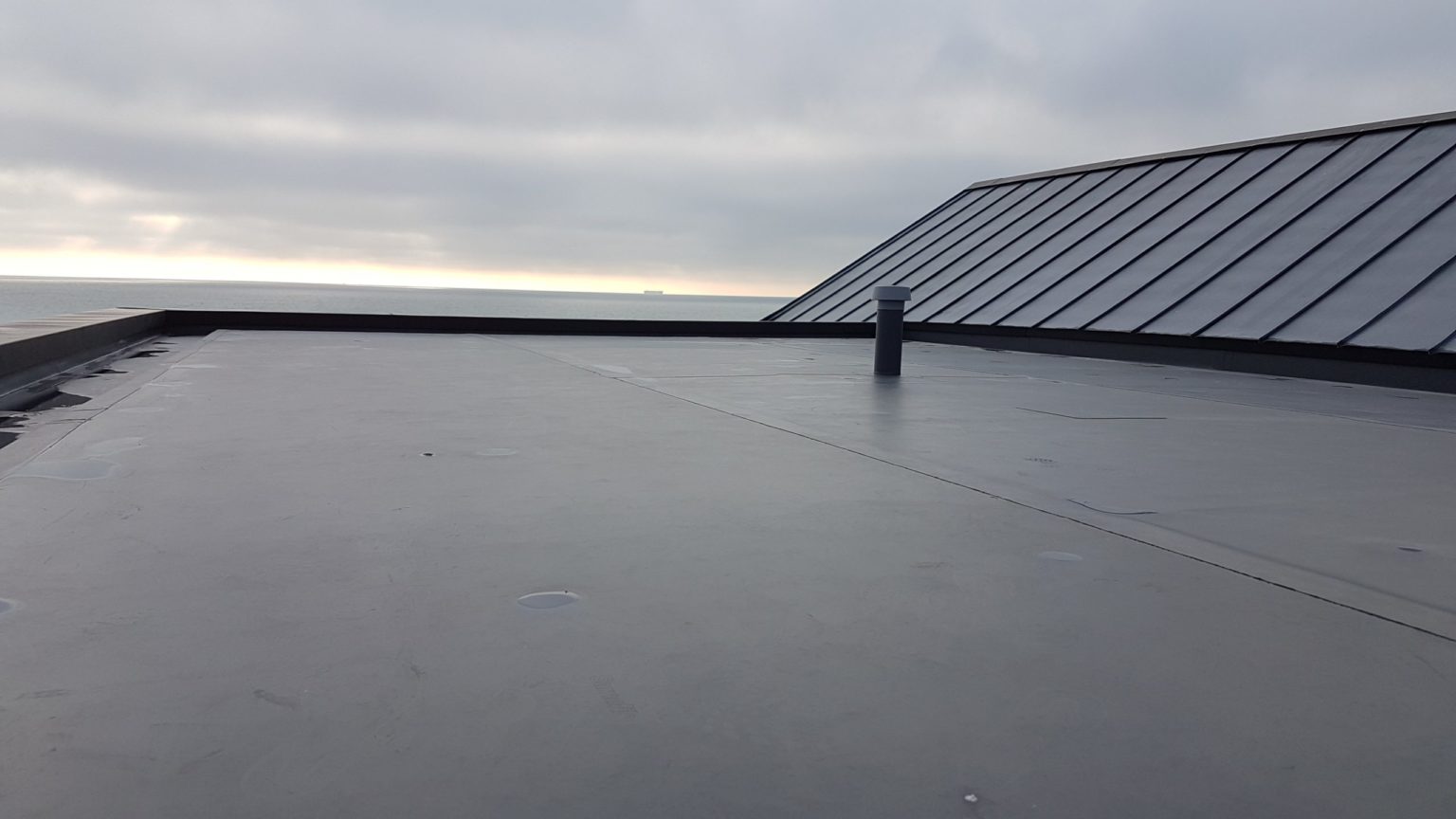
Thermoplastic PVC & TPO Roof Membrane
Thermoplastic PVC (polyvinyl chloride) and TPO roof membrane are two common materials used in commercial roofing projects. PVC and TPO are both single-ply membranes. And they’re typically used in flat and low slope roofs. EPDM is another single-ply commercial roofing system.
Pros and Cons
- Good Value. TPO single-ply membranes are an inexpensive commercial roofing option. And while PVC is not as budget-friendly as TPO, both roof systems will typically last 20 years or more, making them a valuable roof material.
- Durability. TPO is resistant to moisture, heat, dirt accumulation, and more. And PVC is resistant to chemicals and fire. These are materials often found at manufacturing and commercial warehouses, making this a viable roof system for those buildings.
On the cons list, both commercial PVC and TPO roofing systems require professional installation to ensure longevity. And PVC roofing does not do as well as TPO in colder climates. The PVC commercial roofing systems have a history of becoming brittle or cracking in frigid environments.
Shingle Roofing
Shingle roofing is a widespread roof type in commercial roofing. It is also found in many residential areas and is a popular roof type throughout the United States. Shingles are a good option for all roof types, including a sloped or commercial flat roof.
Pros and Cons
- Inexpensive. One of the reasons an asphalt roof system is so utilized is its low cost. For example, a metal roof may cost between $8 and $16 per square foot, and asphalt shingles come in around $2 to $6 per square foot.
- Durability. An asphalt commercial roofing system is relatively resistant to common enemies like fire, algae, and heat. And with proper installation, these commercial roofing systems can last more than 20 years, making them a great value.
On the con side, the granules on an asphalt commercial roof can easily become dislodged in a hail or wind storm. This weakens the commercial roofing system. Damage can also occur to these commercial roofing systems when exposed to excessive moisture or heat.
How to Choose Your Commercial Roofing Material
We know there are many choices on the market for commercial roofing. Without a complete guide, you may be wondering how to choose between options like asphalt shingles and membrane roofing. And, if both are an option, what is the best choice for your building?
Do you have a flat roof, slope roof, or low slope roof?
If you’re asking these questions, it’s time to talk to a professional. It is highly recommended that any commercial roof be installed by a professional contractor with an expert team. This ensures that you’ll get the most value out of your roofing investment. It also gives you peace of mind that you have a specialist in your corner to help you make the best decision.
Contact CCI For All Your Commercial Roofing Needs
At CCI, our team starts with a free, no-cost, no-obligation free roof inspection. Our expert contractor will come to your building and meet with your representative. During the inspection, our crew will look at your existing structure and roofing. They’ll take note of any problems and collect measurements, etc. Once they’re back on the ground, they’ll talk to you and answer any questions. With all of this information, our team can be a complete guide to help you choose the best roofing solution for your needs.
Quality Materials for Your Roof
We work only with quality manufactures and product lines, regardless of roof types. This ensures our clients can trust in the type of work we do and the products they choose. It’s our goal to provide the absolute best materials and professional work.
Exceptional Customer Service
We know that your building and commercial roof are both big investments and business assets, so we treat them like they were ours. Every CCI roofing contractor knows that your roofing solutions have to work for you. And we’ve served on everything from large commercial warehouses to apartment buildings and more.
Book A Free Inspection
Click here to schedule your free, no-cost, no-obligation commercial roof inspections. We know all types of commercial roofing systems – from asphalt to PVC and TPO to a metal roof – and we can help you get the right commercial roof for your project. Call us at 703-754-9551 or send us an email to schedule an appointment today!
Related Pages
Looking for a price? Get a no cost, no obligation free estimate.
Trusted by Industry Experts

